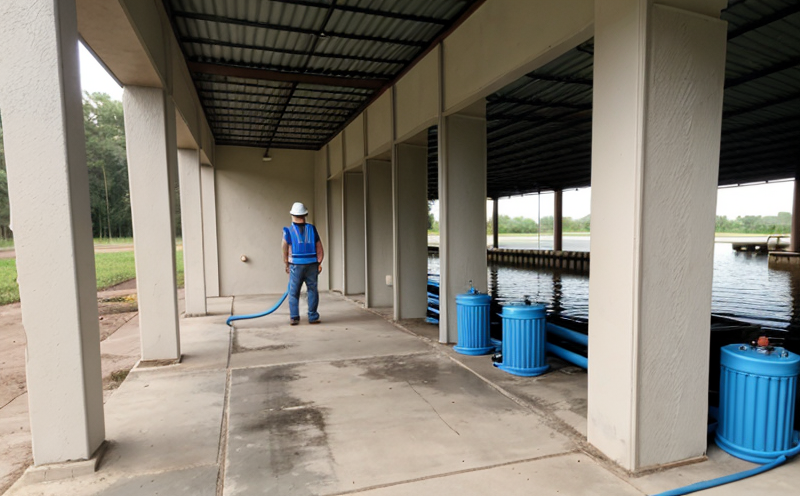Water intake system inspection
The water intake system is a critical component in ensuring reliable and safe delivery of potable water to end users. This system plays an essential role in preventing contamination, maintaining water quality standards, and complying with regulatory requirements. The integrity of the water intake system can be compromised by various factors including biofouling, sediment accumulation, and structural damage caused by external forces such as marine growth or physical stress.
Water intake systems are typically located at the point where a municipal or industrial facility draws its supply of water from natural sources like lakes, rivers, or oceans. These locations often present challenging environmental conditions that can impact the performance and lifespan of the system components. Regular inspections help to identify potential issues before they escalate into major problems requiring extensive repairs or replacements.
The inspection process involves several key steps aimed at assessing both the structural integrity and operational efficiency of the intake structure. Visual examinations are conducted first, followed by detailed assessments using specialized equipment such as sonar imaging for submerged areas and underwater cameras. Sampling of water quality parameters is also performed to evaluate potential contamination risks. Ultrasonic testing may be used to detect any pitting or erosion in metallic components.
Once the inspection findings have been compiled, they are analyzed against relevant industry standards including ISO 14025 for environmental performance assessment and EN 13485 which pertains specifically to quality management systems within manufacturing environments. Based on these evaluations, recommendations will be provided regarding necessary maintenance actions or preventive measures that can extend the life cycle of the water intake system while ensuring continued compliance with all applicable regulations.
For effective implementation of inspection procedures, it is important for facilities to partner with experienced laboratories capable of providing comprehensive testing services tailored specifically to their unique requirements. By leveraging advanced technologies and best practices throughout each stage of the process—from planning through reporting—such partnerships enable organizations to maintain optimal performance levels over time.
Applied Standards
The inspection of water intake systems adheres closely to international standards that ensure both environmental protection and public health. Relevant guidelines include ISO 14025 on environmental management systems which provides criteria for measuring the environmental performance of organizations across all sectors including those dealing with natural resource extraction such as water supply operations.
EN 13485 addresses quality assurance in manufacturing processes relevant to medical devices but extends its principles to cover similar aspects within industrial settings where clean water production is crucial. Additionally, ASTM D6702 specifies methods for evaluating the resistance of materials used in contact with potable water against biofouling organisms which can affect the functionality and longevity of intake structures.
These standards collectively contribute towards establishing robust frameworks that guide every aspect from initial design considerations right through to ongoing monitoring activities. Compliance ensures not only adherence to legal requirements but also promotes sustainable practices beneficial for both current stakeholders as well as future generations who depend on safe drinking water supplies.
Scope and Methodology
The scope of a comprehensive water intake system inspection encompasses various aspects designed to assess the overall health and functionality of this critical infrastructure. This includes evaluating the structural integrity, operational efficiency, and environmental impact associated with the intake structure itself as well as its surrounding ecosystem.
To begin with, visual inspections are carried out to examine visible signs of wear and tear or any other abnormalities on external surfaces such as pipelines leading into the facility. Following this initial assessment, more detailed examinations using advanced technologies like sonar imaging for underwater sections provide insights into conditions beyond direct line-of-sight observation.
Water quality sampling is conducted at multiple points throughout the intake system to collect data on parameters including temperature, pH levels, turbidity, and microbial content among others. This information helps in determining whether there are any deviations from established benchmarks that could indicate contamination risks or other issues requiring attention.
In addition to these technical evaluations, considerations regarding compliance with regulatory requirements must also be taken into account during the inspection process. Relevant codes such as ISO 14025 and EN 13485 guide organizations on how best to implement sustainable practices throughout all stages from planning through execution. By adhering strictly to these guidelines, facilities can ensure not only their own compliance but also contribute positively towards broader environmental goals.
Use Cases and Application Examples
The application of water intake system inspections extends across multiple sectors including municipal utilities, industrial plants, and even private residential communities where access to clean drinking water is paramount. For instance, in the case of a large metropolitan area relying heavily on surface water sources for its population's needs, regular inspections are necessary to prevent contamination incidents that could result in widespread illness or economic losses.
Similarly, within manufacturing environments where product quality depends significantly upon consistent supply chains involving potable water, any disruption due to inadequate intake systems can have severe consequences. By incorporating advanced testing methodologies into routine maintenance schedules, companies can proactively address potential problems before they become critical failures leading to downtime or loss of production.
Residential communities also benefit greatly from thorough inspections conducted periodically by qualified professionals using state-of-the-art equipment and techniques. Ensuring that local water supplies meet strict health standards helps build trust among residents regarding the reliability and safety of their infrastructure investments.
In conclusion, implementing rigorous inspection protocols for water intake systems not only enhances operational efficiency but also fosters long-term sustainability through proactive management practices aligned with recognized global standards.





